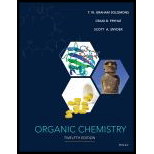
Concept explainers
Interpretation:
The structure of isodrin is to be proposed with the help of given reaction which form isodrin.
Concept introduction:
Diels–Alder reaction is between a conjugate diene and a reactant containing double bond (dienophile) to form the product and the product is called adduct.
Diels–Alder reactions are highly stereospecific. The configuration, if dienophile is retained in the product and the reaction, is syn addition.
The dienes react with dienophiles in cis forms rather than trans forms.
Endo and exo refers to the orientation of dienophile and its electron withdrawing group, when it reacts with a diene in Diels–Alder reaction.
The reaction with orientation of electron withdrawing group of dienophiles under the
The reaction with orientation of electron withdrawing group of dienophiles away from the
Endo is favored in the transition state of Diels–Alder reaction because of its lower energy.
If a compound is stable, it has lower energy, and if a compound is unstable, it has higher energy.
The Diels–Alder reaction is the reaction where the conjugate addition of a conjugate diene on
The reaction is
There is a high degree of stereo selectivity due to concerted mechanism involved and it is useful in synthetic organic reactions.
Want to see the full answer?
Check out a sample textbook solution
Chapter SRP Solutions
EBK ORGANIC CHEMISTRY
- The reaction of a phosphonium ylide with a ketone or aldehyde produces an alkene, but, as shown in Problem 17.57, the reaction of a sulfonium ylide produces an epoxide. Explain why. Hint: What is the major driving force for the Wittig reaction to produce an alkene? The S-O bond energy in dimethyl sulfoxide is 362 kJ/mol.arrow_forwardDiphenylacetylene can be synthesized by the double dehydrohalogenation of 1,2-dibromo-1,2-diphenylethene. The sequence starting from (E)-1,2-diphenylethene consists of bromination to give the dibromide, followed by dehydrohalogenation to give a vinylic bromide, then a second dehydrohalogenation to give diphenylacetylene.(a) What is the structure, including stereochemistry, of the vinylic bromide?(b) If the sequence starts with (Z)-1,2-dibromo-1,2-diphenylethene, what is (are) the structure(s) of the intermediate dibromide(s)? What is the structure of the vinylic bromide?arrow_forwardSynthesize from benzene. (Hint: All of these require diazonium ions.) 2-methyl-5-hydroxybenzoic acidarrow_forward
- Name and Draw the Phenolof all possible chemical (Electrophilic aromatic substitution) reactions of the compound namely; Halogenation (Chlorination or Bromination) Nitrationarrow_forwardprovide synthetic steps Explainarrow_forwardSynthesize from benzene. (Hint: All of these require diazonium ions.) ) 4-methoxyanilinearrow_forward
- The Friedel-Crafts Alkylation of p-xylene n-propyl bromide can result in an isopropyl as well as n-propyl substitution. A) Write the chemical equation involved in this reaction. B) Which will be the major and minor product? What do you expect will be the ratio of n-propyl to isopropyl substitution for p-xylene?arrow_forwardWrite the mechanism for the following reactions. Explain detail each steps of reactions.a) Halogenation of benzene b) Nitration of benzene c) Sulfonation of benzenearrow_forwardKepone, aldrin, and chlordane are synthesized from hexachlorocyclopentadiene and other five-membered-ring compounds. Show how these three pesticides are composed of two five-membered rings.arrow_forward
- Substitutions on aromatic rings are generally carried out by electrophilic substitution, but for the synthesis of phenolic compounds and alkoxy benzene it is carried out by nucleophilic substitution, explain why this is so .arrow_forwardStyrene (vinylbenzene) undergoes electrophilic aromatic substitution much faster thanbenzene, and the products are found to be primarily ortho- and para-substituted styrenes.Use resonance forms of the intermediates to explain these results.arrow_forwardShow how to synthesize each of the following trisubstituted benzenes from a unsubstituted benzene.arrow_forward

 Organic Chemistry: A Guided InquiryChemistryISBN:9780618974122Author:Andrei StraumanisPublisher:Cengage Learning
Organic Chemistry: A Guided InquiryChemistryISBN:9780618974122Author:Andrei StraumanisPublisher:Cengage Learning
 Organic ChemistryChemistryISBN:9781305580350Author:William H. Brown, Brent L. Iverson, Eric Anslyn, Christopher S. FootePublisher:Cengage Learning
Organic ChemistryChemistryISBN:9781305580350Author:William H. Brown, Brent L. Iverson, Eric Anslyn, Christopher S. FootePublisher:Cengage Learning



